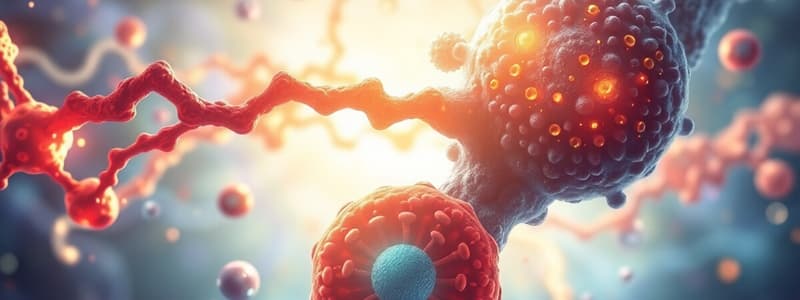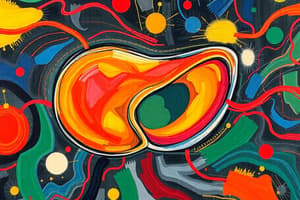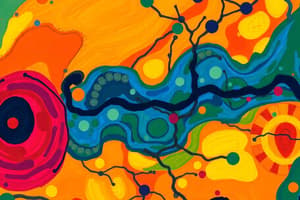Podcast
Questions and Answers
What is the difference between catabolism and anabolism?
What is the difference between catabolism and anabolism?
- Catabolism breaks molecules down to produce energy, while anabolism builds up body tissues. (correct)
- Catabolism and anabolism are the same processes with different names.
- Catabolism stores energy, while anabolism releases it.
- Catabolism builds molecules, while anabolism breaks them down.
Which type of work involves moving molecules across membranes?
Which type of work involves moving molecules across membranes?
- Transport Work (correct)
- Chemical Work
- Thermal Work
- Mechanical Work
What happens to the oxidation state of a molecule during oxidation?
What happens to the oxidation state of a molecule during oxidation?
- It remains unchanged.
- It increases as the molecule loses electrons. (correct)
- It decreases as the molecule gains electrons.
- It fluctuates depending on the medium.
What role do activated carrier molecules play in cellular energy transformations?
What role do activated carrier molecules play in cellular energy transformations?
How does lowering activation energy affect reaction rates?
How does lowering activation energy affect reaction rates?
What is the transition state in enzyme-catalyzed reactions?
What is the transition state in enzyme-catalyzed reactions?
What defines the active site of an enzyme?
What defines the active site of an enzyme?
What effect do enzymes have on the activation energy of a reaction?
What effect do enzymes have on the activation energy of a reaction?
What does Vmax represent in enzyme kinetics?
What does Vmax represent in enzyme kinetics?
Which statement best describes Km?
Which statement best describes Km?
What distinguishes competitive inhibition from non-competitive inhibition?
What distinguishes competitive inhibition from non-competitive inhibition?
What is a key characteristic of irreversible enzyme inhibition?
What is a key characteristic of irreversible enzyme inhibition?
How do cofactors differ from coenzymes?
How do cofactors differ from coenzymes?
Which effect does increasing temperature have on enzyme activity within a certain limit?
Which effect does increasing temperature have on enzyme activity within a certain limit?
What happens when enzymes are exposed to extreme pH levels?
What happens when enzymes are exposed to extreme pH levels?
What is the primary result of the digestion stage in cellular metabolism?
What is the primary result of the digestion stage in cellular metabolism?
What role do second messengers play in signal transduction?
What role do second messengers play in signal transduction?
Which type of signaling involves a cell sending signals through the bloodstream to distant cells?
Which type of signaling involves a cell sending signals through the bloodstream to distant cells?
Which component acts as the 'worker' in the signal transduction process?
Which component acts as the 'worker' in the signal transduction process?
What is the primary function of G-Protein Coupled Receptors (GPCRs) in signal transduction?
What is the primary function of G-Protein Coupled Receptors (GPCRs) in signal transduction?
Which of the following best describes autocrine signaling?
Which of the following best describes autocrine signaling?
What distinguishes receptor tyrosine kinases (RTKs) from other receptor types?
What distinguishes receptor tyrosine kinases (RTKs) from other receptor types?
During the adrenaline signaling process in muscle cells, what is the primary result of the signaling cascade?
During the adrenaline signaling process in muscle cells, what is the primary result of the signaling cascade?
In which type of receptor do ligands typically enter the cell and affect gene expression directly?
In which type of receptor do ligands typically enter the cell and affect gene expression directly?
What is the first step in the activation of Receptor Tyrosine Kinases (RTKs) during signal transduction?
What is the first step in the activation of Receptor Tyrosine Kinases (RTKs) during signal transduction?
Which of the following molecules is considered a second messenger in cell signaling?
Which of the following molecules is considered a second messenger in cell signaling?
How do membrane receptor-mediated and nuclear receptor-mediated signal transduction mechanisms primarily differ?
How do membrane receptor-mediated and nuclear receptor-mediated signal transduction mechanisms primarily differ?
What role do protons play in chemiosmotic coupling within mitochondria?
What role do protons play in chemiosmotic coupling within mitochondria?
What is the primary function of the β subunits in the FoF1 ATP synthase complex?
What is the primary function of the β subunits in the FoF1 ATP synthase complex?
What is the primary purpose of glycolysis from a cellular perspective?
What is the primary purpose of glycolysis from a cellular perspective?
During which stage of glycolysis is glucose converted into two identical 3-carbon molecules?
During which stage of glycolysis is glucose converted into two identical 3-carbon molecules?
What are the overall inputs required for glycolysis?
What are the overall inputs required for glycolysis?
Why is it essential for cells to regenerate NAD+ after glycolysis?
Why is it essential for cells to regenerate NAD+ after glycolysis?
How do cells regenerate NAD+ in the absence of oxygen?
How do cells regenerate NAD+ in the absence of oxygen?
What is the role of acetyl CoA in cellular metabolism?
What is the role of acetyl CoA in cellular metabolism?
What are the main products of the citric acid cycle?
What are the main products of the citric acid cycle?
What is the energy transformation that occurs during oxidative phosphorylation?
What is the energy transformation that occurs during oxidative phosphorylation?
Flashcards
Metabolism
Metabolism
All chemical and physical activities in the body that use or convert energy.
Catabolism
Catabolism
Breaks down molecules to release energy.
Anabolism
Anabolism
Builds molecules, using energy.
Activation Energy
Activation Energy
Signup and view all the flashcards
Enzyme
Enzyme
Signup and view all the flashcards
Active Site
Active Site
Signup and view all the flashcards
Substrate
Substrate
Signup and view all the flashcards
Biological Oxidation/Reduction
Biological Oxidation/Reduction
Signup and view all the flashcards
Michaelis-Menten equation
Michaelis-Menten equation
Signup and view all the flashcards
Vmax
Vmax
Signup and view all the flashcards
Km
Km
Signup and view all the flashcards
Reversible inhibition
Reversible inhibition
Signup and view all the flashcards
Irreversible inhibition
Irreversible inhibition
Signup and view all the flashcards
Competitive inhibition
Competitive inhibition
Signup and view all the flashcards
Non-competitive inhibition
Non-competitive inhibition
Signup and view all the flashcards
Food Molecule breakdown stages
Food Molecule breakdown stages
Signup and view all the flashcards
Glycolysis Purpose
Glycolysis Purpose
Signup and view all the flashcards
Glycolysis Inputs
Glycolysis Inputs
Signup and view all the flashcards
Glycolysis Outputs
Glycolysis Outputs
Signup and view all the flashcards
NAD+ Regeneration (Fermentation)
NAD+ Regeneration (Fermentation)
Signup and view all the flashcards
NAD+ Regeneration (Aerobic Respiration)
NAD+ Regeneration (Aerobic Respiration)
Signup and view all the flashcards
Acetyl CoA Role
Acetyl CoA Role
Signup and view all the flashcards
Citric Acid Cycle
Citric Acid Cycle
Signup and view all the flashcards
Oxidative Phosphorylation
Oxidative Phosphorylation
Signup and view all the flashcards
Receptor Tyrosine Kinases (RTKs)
Receptor Tyrosine Kinases (RTKs)
Signup and view all the flashcards
Second Messenger
Second Messenger
Signup and view all the flashcards
Electron Transport Chain (ETC)
Electron Transport Chain (ETC)
Signup and view all the flashcards
Proton Motive Force
Proton Motive Force
Signup and view all the flashcards
ATP Synthase
ATP Synthase
Signup and view all the flashcards
Oxidative Phosphorylation
Oxidative Phosphorylation
Signup and view all the flashcards
Cell Signaling
Cell Signaling
Signup and view all the flashcards
Signal Transduction Components
Signal Transduction Components
Signup and view all the flashcards
Ligand
Ligand
Signup and view all the flashcards
G-Protein Coupled Receptor (GPCR)
G-Protein Coupled Receptor (GPCR)
Signup and view all the flashcards
Receptor Tyrosine Kinase (RTK)
Receptor Tyrosine Kinase (RTK)
Signup and view all the flashcards
Second Messengers
Second Messengers
Signup and view all the flashcards
Autocrine Signaling
Autocrine Signaling
Signup and view all the flashcards
Study Notes
Energy and Metabolism
- Metabolism encompasses all chemical and physical activities using or converting energy
- Catabolism breaks down molecules to produce energy
- Anabolism builds up body tissues and energy stores
Energy and Cell Work
- Energy is the capacity to do work
- Chemical work: molecule synthesis
- Mechanical work: movement
- Transport work: molecule movement across membranes
Oxidation and Reduction
- Oxidation: molecule loses electrons (or gains oxygen), increasing its oxidation state
- Reduction: molecule gains electrons (or loses oxygen), decreasing its oxidation state
Activated Carrier Molecules
- Store and transfer energy in cells
- Capture energy from processes like food breakdown, powering activities like muscle contraction and molecule synthesis
Enzymes and Activation Energy
- Enzymes lower activation energy, speeding up chemical reactions
- Activation energy: minimum energy needed to start a reaction
- Lowering activation energy accelerates reactions
Enzyme Activity and Substrate Specificity
- Active site: enzyme region where substrate binds, reacting
- Substrate: specific molecule upon which an enzyme acts
- Enzyme's active site shape and properties are specific, like a “lock and key,” ensuring only corresponding substrates bind
Enzyme Inhibition
- Competitive inhibition: inhibitor resembles substrate, binding to the active site, blocking substrate binding. It can be overcome by increasing substrate concentration.
- Non-competitive inhibition: inhibitor binds to a site other than the active site, changing the enzyme's shape and reducing its activity. It cannot be overcome by increasing substrate concentration
Cofactors and Coenzymes
- Cofactors: inorganic molecules helping stabilize or assisting enzyme reaction (ex. metal ions)
- Coenzymes: organic molecules (ex. vitamins) transferring chemical groups between molecules
Temperature and pH Effects
- Enzyme activity increases with temperature but decreases significantly beyond optimal temperature
- Enzyme activity is best at optimal pH; too acidic or basic changes enzyme structure and reduces activity
Food Energy Stages
- Digestion: proteins, polysaccharides, and fats break down into smaller molecules (amino acids, sugars, and fatty acids)
- Glycolysis: partially breaks down glucose, producing ATP and NADH
- Oxidative Phosphorylation: uses energy from molecules' oxidation to form ATP using inorganic phosphate
Glycolysis
- Purpose: break down glucose for quick energy and production of molecules needed for further energy production
- Inputs: glucose, 2 NAD+, 2 ADP + 2Pi
- Outputs: 2 pyruvate, 2 NADH, 2 ATP (net gain)
Acetyl CoA
- Delivers energy-rich molecules to the citric acid cycle from broken-down sugars, fats, and proteins
Citric Acid Cycle and Oxidative Phosphorylation
- Citric Acid Cycle: produces energy carriers (NADH and FADH2) and CO2
- Oxidative Phosphorylation: energy carriers (NADH and FADH2) power ATP production using an electron transport chain and electrochemical gradient
Studying That Suits You
Use AI to generate personalized quizzes and flashcards to suit your learning preferences.




